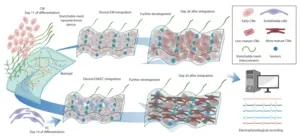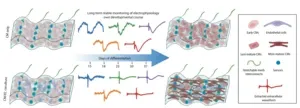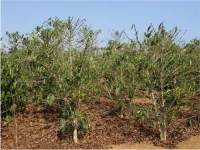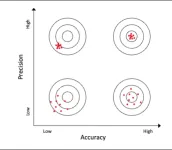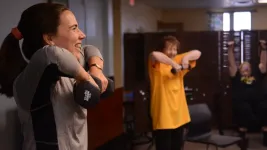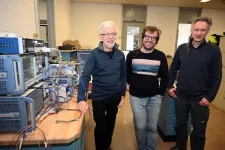(Press-News.org) Research in animal models has demonstrated that stem-cell derived heart tissues have promising potential for therapeutic applications to treat cardiac disease. But before such therapies are viable and safe for use in humans, scientists must first precisely understand on the cellular and molecular levels which factors are necessary for implanted stem-cell derived heart cells to properly grow and integrate in three dimensions within surrounding tissue.
New findings from the Harvard John A. Paulson School of Engineering and Applied Sciences (SEAS) make it possible for the first time to monitor the functional development and maturation of cardiomyocytes – the cells responsible for regulating the heartbeat through synchronized electrical signals – on the single-cell level using tissue-embedded nanoelectronic devices. The devices – which are flexible, stretchable, and can seamlessly integrate with living cells to create “cyborgs” – are reported in a Science Advances paper.
“These mesh-like nanoelectronics, designed to stretch and move with growing tissue, can continuously capture long-term activity within individual stem-cell derived cardiomyocytes of interest,” says Jia Liu, co-senior author on the paper, who is an assistant professor of bioengineering at SEAS, where he leads a lab dedicated to bioelectronics.
Liu’s team, which specializes in engineering nanoelectronics to bridge the gap between living tissue and electronics, has developed several mesh-like, minimally invasive flexible nanoelectronic sensors designed to be embedded with natural tissues without disturbing normal cellular grown or function.
“Nature showed us the solution to monitoring tissue in 3D,” Liu says. ”We were inspired by the way neural tubes fold during development, stretching as cells migrate and take shape into tissue volume.”
His team created their first cyborg organoid in 2019 to test the idea of using a mesh-like nanoelectronic structure, and has previously demonstrated that these types of flexible nanoelectronics can be safely implanted into living mice without disrupting the function of nearby cells.
In their latest study, Liu’s lab joined forces with Richard Lee and his team at Harvard Stem Cell Institute and used the nanoelectronics to monitor electrical activity of stem-cell derived cardiomyocytes. To do so, the researchers cultured cells onto a sheet made of commercially available cellular matrix known as “Matrigel” and the mesh-like nanoelectronic sensor (which contains a flexible grid of microelectrodes). As the cells grew and developed into a small organoid structure, the researchers observed that the sheet easily stretched and accommodated the stem-cell derived tissues as they proliferated and expanded in 3D.
Using these techniques in in vitro experiments, the team discovered that the blood vessel lining cells that regulate blood flow between vessels and surrounding tissues (called endothelial cells) play a previously underestimated but crucial role in the rapid and functional maturation of stem-cell derived cardiomyocytes. When cultured together in a 3D cardiac tissue matrix, cardiomyocytes underwent “extraordinary electrical maturation” in the presence of endothelial cells.
Over the course of seven weeks of monitoring the developing organoids, the team observed that proximity to endothelial cells had a direct impact. Cardiomyocytes cultured next to endothelial cells matured faster compared to cardiomyocytes located farther away from endothelial cells, and they also displayed electrical characteristics typically found in healthy heart tissue.
The new insight is a leap forward for engineering stem-cell derived cardiac tissues. Experimental preclinical research in animals with human-like hearts has proven it’s difficult to engineer and transplant stem-cell derived cardiomyocytes that can beat in tandem with surrounding heart tissue for extended periods of time. Immature cardiomyocytes transplanted into an animal’s heart tend to beat to their own drum, and this electrical misfire can cause dangerous irregular heartbeats. That’s why the discovery that co-culturing stem-cell-derived cardiomyocytes with endothelial cells can create more functionally mature cardiomyocytes is so significant.
In their new paper, the team also describes using a novel machine-learning-based analysis to interpret the electrical activity captured by the tissue-embedded nanoelectronic devices, enabling continuous monitoring of the electrical waves generated by maturing cardiomyocytes of interest and enabling a better understanding of how the tissue microenvironment influences electrical stability.
Liu says the nanoelectronic devices and machine-learning-based analysis represent new platform technologies for monitoring and managing stem-cell derived tissue implants – enabling scientists to culture cyborgs made from both living tissues and electronics that can be controlled with a high degree of specificity. In cardiac tissues, he envisions that someday these cyborgs could even be used in a sophisticated, real-time feedback system to detect abnormal electrical activity in cardiomyocytes and provide highly targeted voltage, acting like a nanoscale pacemaker, to help correct implanted cells and ensure they continue to beat in rhythm with the rest of the heart.
“If we have both nanoelectronic sensors and stimulators, we can monitor electrical activity and use feedback to pace implanted tissues into the same frequency as surrounding tissues,” Liu says. “This approach could be adapted to so many other types of stem-cell-derived tissues, such as neuronal tissues and pancreatic organoids.”
He also says this nanoelectronics platform approach could be used in drug screening, providing single-cell-level, continuous analysis of how tissues respond to different compounds and therapies.
Harvard’s Office of Technology Development has protected the intellectual property arising from this study and is exploring commercialization opportunities.
Additional authors include Zuwan Lin, Jessica C. Garbern, Ren Liu, Qiang Li, Estela M. Juncosa, Hannah L.T. Elwell, Morgan Sokol, Junya Aoyama, Undine-Sophie Deumer, Emma Hsiao, and Hao Sheng.
This work was supported by the National Institutes of Health (K08 HL150335, HL151684, HL137710, and 1DP1DK130673), National Science Foundation (NSF ECCS-2038603), the William Milton Fund, a Harvard Stem Cell Collaborative Seed Grant, a Blavatnik Biomedical Accelerator Pilot Grant, an American Heart Association Career Development Award, a Boston Children’s Hospital Office of Faculty Development Career Development Award, and an Aramont Fellowship for Emerging Science Research.
END
Cyborg technology analyzes the functional maturation of stem-cell derived heart tissue
Tissue-embedded stretchable nanoelectronics enable insights into the influence of neighboring cells on stem-cell-derived cardiomyocyte growth and performance
2023-03-08
ELSE PRESS RELEASES FROM THIS DATE:
Anthropogenic climate change poses systemic risk to coffee cultivation
2023-03-08
Coffee is important to the economies of coffee producing regions. A study published in PLOS Climate by Doug Richardson at CSIRO Oceans & Atmosphere, Hobart, Tasmania, Australia and colleagues suggests that climate change may significantly affect land where coffee is cultivated.
Coffee plants are sensitive to climate variability and change. However, the impact of synchronous climate hazards occurring in multiple areas important for coffee production is unknown. In order to better understand how large-scale climate modes such as El Niño ...
Celebrity sightings have a built-in contradiction
2023-03-08
RIVERSIDE, Calif. -- Their popularity makes celebrities easy to spot. Strangers, however, can also get mistaken for celebrities, resulting in cases of false “celebrity sightings.” In attempting to explain the contradiction, a University of California, Riverside, study reports that celebrity faces are remembered more precisely but less accurately.
Precision, in this context, refers to how memories for a particular face resemble each other over repeated memory retrievals, which can be likened to the clustering of arrows on a target in archery. Accuracy measures ...
A new class of drugs could prevent resistant COVID-19 variants, study finds
2023-03-08
New Haven, Conn. — The constant evolution of new COVID-19 variants makes it critical for clinicians to have multiple therapies in their arsenal for treating drug-resistant infections. Researchers have now discovered that a new class of oral drugs that acts directly on human cells can inhibit a diverse range of pathogenic SARS-CoV-2 strains.
In their newly published study, the team found a novel mechanism through which the gene that expresses angiotensin converting enzyme-2 (ACE-2)—the cellular receptor to which SARS-CoV-2 ...
Swan Hellenic and SETI Institute announce lecturers for Explore Space at Sea Series
2023-03-08
March 8, 2023, Mountain View, CA – The SETI Institute and Swan Hellenic announce SETI Institute guest lecturers who will offer cruise guests expert insights into the history and latest discoveries in astronomy, astrophysics, astrobiology and planetary science, and the quest to find other forms of life within and beyond our solar system. This quest takes SETI Institute researchers to the planet’s most remote and inhospitable corners to explore life, including Antarctica, where the Swan Hellenic fleet is present for several months every year.
Outlining ...
New articles for Geosphere posted early online
2023-03-08
Boulder, Colo., USA: GSA’s dynamic online journal, Geosphere, posts articles online regularly. Topics this month include an analysis of geoscience job applications; Uturuncu volcano, Bolivia; Picture Gorge Basalt; and the Red Bluff Granite Suite. You can find these articles at https://geosphere.geoscienceworld.org/content/early/recent .
Critical workforce skills for bachelor-level geoscientists: An analysis of geoscience job advertisements
G.W. Shafer; K. Viskupic; A.E. Egger
Understanding the skills ...
Human Brain Project: spin-off receives EIC grant to develop energy-efficient AI technology
2023-03-08
The European Innovation Council (EIC) has recently announced that it will award a Transition grant to SpiNNcloud Systems GmbH, a deep-tech startup based in Saxony, Germany.
The team from SpiNNcloud Systems GmbH, a spin-off from Professor Christian Mayr’s research group at Technische Universität Dresden, is receiving a grant of 2.5 million euros for their groundbreaking project, “SpiNNode: SpiNNaker2 on the edge.”
“SpiNNaker2 is a bio-inspired supercomputer which was developed at my Chair in collaboration with Prof. Steve Furber’s research group at the University of Manchester as part ...
New GSA Bulletin articles published online ahead of print
2023-03-08
Boulder, Colo., USA: The Geological Society of America regularly publishes articles online ahead of print. GSA Bulletin topics studied this month include the nature and dynamics of China and Tibet; the Lower Mississippi Valley, USA; and the polarity of Mesozoic arcs along the western margin of North America. You can find these articles at https://bulletin.geoscienceworld.org/content/early/recent .
Magmatic-hydrothermal evolution of long-lived Nb-Ta-(Sn) mineralization in Lianyunshan, NE Hunan, South China
Nuerkanati Madayipu; Huan Li; Safiyanu Muhammad Elatikpo; Michael W. Förster; Hou-Xiang Zhou ...
The ...
Group exercise program for older adults led to more independent exercise despite pandemic restrictions, MU study finds
2023-03-08
COLUMBIA, Mo. -- Sticking with an exercise program can be tough, even during the best of times. But what about during a pandemic?
A new study by the University of Missouri and Oklahoma State University found that even when gyms were closed and there were other COVID-19 restrictions limiting face-to-face meetings, older adults who completed the Stay Strong, Stay Healthy exercise program — created at MU in 2005 — continued to maintain long-term exercise habits independently, which resulted in improved lifestyle changes and an increase in both physical energy and self-confidence.
“We ...
Incident atrial fibrillation appears to heighten dementia risk
2023-03-08
People with a recent diagnosis of atrial fibrillation (AF), the most common irregular heart rhythm, have a modestly higher risk of developing dementia than people without the condition, according to research published today.
“Previous studies that have examined the link between atrial fibrillation and dementia have yielded conflicting results, and we hope that our study’s large sample size helps to establish confidence in our findings,” said Dr. Nisha Bansal, a professor of medicine at the University of Washington School of Medicine. “The study also included a community based, diverse population, which may increase the generalizability ...
Lunar telescope will search for ancient radio waves
2023-03-08
UPTON, NY—Scientists at the U.S. Department of Energy’s (DOE) Brookhaven National Laboratory are leading a new effort to land a radio telescope on the moon. If successful, the project will mark the first step towards exploring the Dark Ages of the universe.
The Dark Ages are an early era of cosmological history starting about 380,000 years after the Big Bang. There were no stars or planets in the Dark Ages. It’s a point in time that scientists have never been able to observe. Though radio waves from the Dark Ages still linger in space, the abundance of radio interference on Earth has masked these signals from scientists seeking to study them.
If ...
LAST 30 PRESS RELEASES:
NTP-enhanced lattice oxygen activation in Ce-Co catalysts for low-temperature soot combustion
Synergistic interface engineering in Cu-Zn-Ce catalysts for efficient CO2 hydrogenation to methanol
COVID-19 leaves a lasting mark on the human brain
Scientists use ultrasound to soften and treat cancer tumors without damaging healthy tissue
Community swimming program for Black youth boosts skills, sense of belonging, study finds
Specific depressive symptoms in midlife linked to increased dementia risk
An ‘illuminating’ design sheds light on cholesterol
Who is more likely to get long COVID?
Study showcases resilience and rapid growth of “living rocks”
Naval Research Lab diver earns Office of Naval Research 2025 Sailor of the Year
New Mayo-led study establishes practical definition for rapidly progressive dementia
Fossil fuel industry’s “climate false solutions” reinforce its power and aggravate environmental injustice
Researchers reveal bias in a widely used measure of algorithm performance
Alcohol causes cancer. A study from IOCB Prague confirms damage to DNA and shows how cells defend against it
Hidden viruses in wastewater treatment may shape public health risks, study finds
Unlock the power of nature: how biomass can transform climate mitigation
Biochar reshapes hidden soil microbes that capture carbon dioxide in farmland
Reducing saturated fat intake shows mortality benefit, but only in high-risk individuals
Manta rays create mobile ecosystems, study finds
Study: Mixed results in using lipoic acid to treat progressive multiple sclerosis
Norbert Holtkamp appointed director of Fermi National Accelerator Laboratory
New agentic AI platform accelerates advanced optics design
Biologists discover neurons use physical signals — not electricity — to stabilize communication
Researchers discover that a hormone can access the brain by hitchhiking
University of Oklahoma researcher awarded funding to pursue AI-powered material design
Exploring how the visual system recovers following injury
Support for parents with infants at pediatric check-ups leads to better reading and math skills in elementary school
Kids’ behavioral health is a growing share of family health costs
Day & night: Cancer disrupts the brain’s natural rhythm
COVID-19 vaccination significantly reduces risk to pregnant women and baby
[Press-News.org] Cyborg technology analyzes the functional maturation of stem-cell derived heart tissueTissue-embedded stretchable nanoelectronics enable insights into the influence of neighboring cells on stem-cell-derived cardiomyocyte growth and performance

